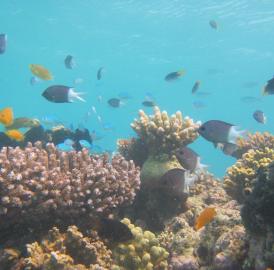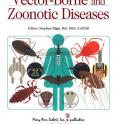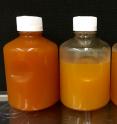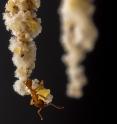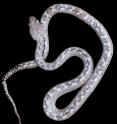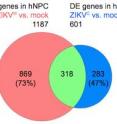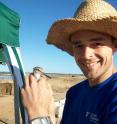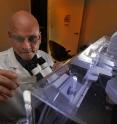Popular Science articles about Biology & Nature
The proteins that domesticated our genomes
EPFL scientists have carried out a genomic and evolutionary study of a large and enigmatic family of human proteins, to demonstrate that it is responsible for harnessing the millions of transposable elements in the human genome. The work reveals the...
First accurate simulation of a virus invading a cell
For the first time, scientists know what happens to a virus' shape when it invades a host cell, thanks to an experiment by researchers at Penn State College of Medicine...
Study reveals how ionising radiation damages DNA and causes cancer
For the first time, researchers from the Wellcome Trust Sanger Institute and their collaborators have been able to identify in human cancers two characteristic patterns of DNA damage caused by...
Seek and you shall find -- bees remain excellent searchers even when ill
Honeybees are hardwired to efficiently search the landscape enabling them to continue working for the greater good of their hives even when they are sick, according to new research co-authored...
Training human antibodies to protect against HIV
During HIV infection, the virus mutates too rapidly for the immune system to combat, but some people produce antibodies that can recognize the virus even two years after infection. With...
Kill them with cuteness: The adorable thing bats do to catch prey
 A Johns Hopkins University researcher noticed the bats he works with cocked their heads to the side, just like his pet Pug.
A Johns Hopkins University researcher noticed the bats he works with cocked their heads to the side, just like his pet Pug.
A cinematic approach to drug resistance
In a creative stroke inspired by Hollywood wizardry, scientists from Harvard Medical School and Technion-Israel Institute of Technology have designed a simple way to observe how bacteria move as they...
Bacteria supply their allies with munitions
 Many bacteria possess molecular spear guns, which they fire at
enemies and rivals, thus putting them out of action. The tips of
these nano-spear guns, known as Type VI secretion...
Many bacteria possess molecular spear guns, which they fire at
enemies and rivals, thus putting them out of action. The tips of
these nano-spear guns, known as Type VI secretion...
Chinese investigators characterize the world of resistance gene exchange among bacteria
Certain antibiotic resistance genes are easily transferred from one bacterial species to another, and can move between farm animals and the human gut. A team led by Chinese researchers has...
Critical information needed in fight to save wildlife
 With global temperatures rising, an international group of 22 top
biologists is calling for a coordinated effort to gather important
species information that is urgently needed to improve predictions for...
With global temperatures rising, an international group of 22 top
biologists is calling for a coordinated effort to gather important
species information that is urgently needed to improve predictions for...
Crab from the Chinese pet market turns out to be a new species of a new genus
 Shimmering carapaces and rattling claws make colourful freshwater
crabs attractive to pet keepers. To answer the demand, fishermen
are busy collecting and trading with the crustaceans, often not
knowing what...
Shimmering carapaces and rattling claws make colourful freshwater
crabs attractive to pet keepers. To answer the demand, fishermen
are busy collecting and trading with the crustaceans, often not
knowing what...
Trees recognize roe deer by saliva
 In spring, the young, delicate shoots in the forest light up,
bright and May green. The buds and shoots are the future of the
forests as they allow young trees...
In spring, the young, delicate shoots in the forest light up,
bright and May green. The buds and shoots are the future of the
forests as they allow young trees...
Snails' speedy insulin
 University of Utah researchers have found that the structure of an
insulin molecule produced by predatory cone snails may be an
improvement over current fast-acting therapeutic insulin. The
finding suggests...
University of Utah researchers have found that the structure of an
insulin molecule produced by predatory cone snails may be an
improvement over current fast-acting therapeutic insulin. The
finding suggests...
Hippo teeth reveal environmental change
 Loss of megaherbivores such as elephants and hippos can allow woody
plants and non-grassy herbs and flowering plants to encroach on
grasslands in African national parks, according to a new...
Loss of megaherbivores such as elephants and hippos can allow woody
plants and non-grassy herbs and flowering plants to encroach on
grasslands in African national parks, according to a new...
Male chemistry primes females for reproduction -- but at a cost
A research team led by a Northwestern University scientist has discovered that male animals, through their invisible chemical "essence," prime female animals for reproduction but with the unfortunate side effect...
Linking RNA structure and function
Several years ago, biologists discovered a new type of genetic material known as long noncoding RNA. This RNA does not code for proteins and is copied from sections of the...
Genetic analysis uncovers 4 species of giraffe, not just 1
 Up until now, scientists had only recognized a single species of
giraffe made up of several subspecies. But, according to the most
inclusive genetic analysis of giraffe relationships to date,...
Up until now, scientists had only recognized a single species of
giraffe made up of several subspecies. But, according to the most
inclusive genetic analysis of giraffe relationships to date,...
The history of beer yeast
 Today's industrial yeast strains are used to make beer, wine,
bread, biofuels, and more, but their evolutionary history is not
well studied. In a Cell paper publishing September 8, researchers...
Today's industrial yeast strains are used to make beer, wine,
bread, biofuels, and more, but their evolutionary history is not
well studied. In a Cell paper publishing September 8, researchers...
Yellow or black, large or small? Ant color and body size respond strongly to environment
 A University of Liverpool study of ants across three continents has
revealed that their colour and size is strongly influenced by their
environment, and that the dominant colour and average...
A University of Liverpool study of ants across three continents has
revealed that their colour and size is strongly influenced by their
environment, and that the dominant colour and average...
Humans may be uniquely identified by the proteins in their hair
 Unique protein markers in hair could be used alongside DNA
profiling for human identification, according to a study published
September 7, 2016 in the open-access journal PLOS ONE by Glendon...
Unique protein markers in hair could be used alongside DNA
profiling for human identification, according to a study published
September 7, 2016 in the open-access journal PLOS ONE by Glendon...
How fungi help trees tolerate drought
The mutualistic relationship between tree roots and ectomycorrhizal (ECM) fungi has been shaping forest ecosystems since their inception. ECM fungi are key players supporting the growth, health and stress tolerance...
More news about Biology & Nature
Biology News in Images
Breaking science news from the newsfeed about Biology & Nature
- DNA reveals Neanderthals' "wild" and "woolly" diet
- Aboriginal hair shows 50,000 years connection to Australia
- Researchers create new material to regrow bone
- A backup copy in the central brain: How fruit flies form orientation memory
- Uncovering New Relationships and Organizational Principles in Protein Interaction Networks
- In battle for real estate, a disordered protein wins out
- Research Uncovers Potential Health Risks of Travel to Mars
- Scientist Details the Indirect Effects of an Invasive Species in Guam
- Pot for pets: Owners treat sick animals with cannabis
- Molecule shown to repair damaged axons
- A three-dimensional map of the genome
- Empathy and awe: ROM ready to show Trout River blue whale to the world
- The proteins that domesticated our genomes
- Caveman menu: Woolly rhino in Belgium, mushrooms in Spain
- The protective layer of prehistoric land plants
- Pushing the limits of organic synthesis
- Cellular senescence prevented by the SETD8 enzyme
- A new tool for genetically engineering the oldest branch of life
- DSM, Evonik form omega-3 joint venture
- While Untangling History of Aquatic Beetle Group, NSF Graduate Researcher Discovers Flaw in Model Used by Biologists
- Poachers kill rhino at French zoo, remove horn
- Vision, not limbs, led fish onto land 385 million years ago
- Salt lake in Australian park turns bright pink
- First Underwater Video Footage of the True's Beaked Whale
- Snake Bit? Chemists Figure Out How to Easily and Cheaply Halt Venom's Spread
- 'Black Swan' Events Strike Animal Populations
- Male infertility research reveals how a new life begins
- Rainy day germs: A light rain can spread soil bacteria far and wide
- Columbus Blue Jackets' Sergei Bobrovsky records third straight shutout
- Bumblebees’ smelly feet help determine where to find lunch
